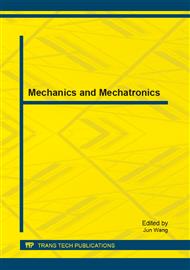[1]
Chen fan. Analysis of digital cinema 3D technology [J]. Modern movie technology. VOL. 1 (2006), P. 29-30.
Google Scholar
[2]
Luo Guier. Some Issues of Depth Peception and Three Dimention Reconstruction from Binocular Stereo Vision[D]. Changsha : Central South University. (2012).
Google Scholar
[3]
Liang Dong, Wei Sui. Research of Geometric Model for Binocular Perception[J]. Journal of image and graphics. VOL. 8 (1998).
Google Scholar
[4]
Murata Hideo. Principles of 3D and 3D filming practice [J]. Modern TV technology (2010), P. 66-69.
Google Scholar
[5]
Nan Zhang. Reserch on high-speed rail prestressed concrete continuous beam bridge design deformation. [R]. Beijing : New Technologies of Railway Engineering (2012).
Google Scholar
[6]
Duan Fuqing. Camera Calibration and 3D Reconstruction Using Parallelism Constraint[J]. Journal of Software. VOL. 6 (2007),P. 1350-1360.
DOI: 10.1360/jos181350
Google Scholar
[7]
Takumu Sugiura; Syota Ichikawa; Nobuyuki Kobayashi; Yoshiki Sugawara; Ayako Torisaka. Reduction of Degrees of Freedom in Three-dimensional ANCF Beam Element by Higher Order Shape Function[R]. Shanghai : The sixth Asian Conference on Multibody Dynamics (2012).
Google Scholar
[8]
Hozumi Kagawa; Masahiro Nagata; Kinzi Satoo. Application of ball screw and slitted disc for overload cluth[R]. Beijing : China and Japan International Symposium on mechanical parts (1993).
Google Scholar
[9]
Huajun Wang. Some Key Technology of Rotary Forging Process for Spiral Bevel Gear[R]. Wuhan : Proceedings of the 2nd International Symposium on Digital Manufacturing (2009).
Google Scholar
[10]
Zhao Peifeng. Research on materical constant values of 6061 Aluminum alloy[J]. Journal of Plasticity Engineering. VOL. 4 (2006).
Google Scholar
[11]
Isao Takahashi, Toshihiko Noguchi. A new responese and high-efficiency control strategy of an motor[J/OL]. IEEE Trans on Ind Appl (1986).
Google Scholar
[12]
Cai Jingjing. Design of Stepping Motor Servo Controller Based on Single-Chip Computer[D]. Inner Mongolia: Inner Mongolia agricultural University (2012).
Google Scholar
[13]
Zhu Guoliang. Development trend of wireless communication technology[J]. Mobile Communications. VOL. 10 (2010).
Google Scholar
[14]
Hui Tan. Controlling system design of high speed stepping motor based on serial communication[R]. Beijing: 2011 4th IEEE International Symposium on Microwave, Antenna, Propagation and EMC Technologies for Wireless Communications (2011).
DOI: 10.1109/mape.2011.6156185
Google Scholar
[15]
Zhao Haiming. Study on the Ultrasonic Distance Measurement Method with High Precision[J]. Journal of Hunan University of Science & Technology(Natural Science Edition), 3 (2006),P. 35-38.
Google Scholar


